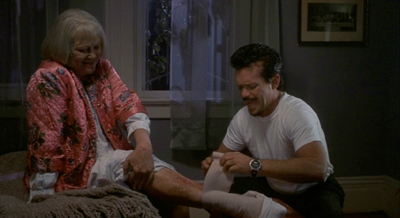
 BUY IT AT AMAZON: CLICK HERE!
BUY IT AT AMAZON: CLICK HERE!
STUDIO: Miramax
MSRP: $29.99
RATED: R
RUNNING TIME: 92 min.
SPECIAL FEATURES:
• The Making of After Image
• Production Notes by Robert Manganelli
• Portraying Death: The Art of Special Effects Makeup
The Pitch
“It’s Blow Up meets Jennifer 8 by way of Children of a Lesser God!”
The Humans
John Mellencamp (Falling From Grace), Terrylene (Legalese, Natural Born Killers), Louise Fletcher (Invaders from Mars), Billy Burke (Ladder 49), Michael Zelniker (Bird, Naked Lunch)
The Nutshell
Crime photographer Joe (Mellencamp, but he’ll always be Johnny Cougar to me) experiences a spiritual crisis after documenting the remains of a murdered girl. You can tell it’s a spiritual crisis because this is one of those thrillers with lots and lots of Catholic imagery, and because the victim’s name is… Christine D’Angelo. Subtle, huh? Finding himself on forced vacation, Joe spends his days hanging out with his brain-damaged brother (Burke), his diabetic aunt (Fletcher), and his aunt’s deaf and frequently unclothed caregiver Lora (Terrylene). But what about Nye (Zelniker), the token creepy guy Joe inadvertently photographed at the scene of the crime? Why does Nye spend all his time in a funky warehouse talking to a camcorder? Who could be out there committing additional murders and taunting Joe with obvious clues? What’s the deal with Lora’s psychic visions, and why do they all look like Prince videos? Could all these things be connected in some mysterious way?

"Ooh yeah, life goes o-onn…"
The Package
A spic ’n span Buena Vista transfer (anamorphic 1.85:1), although dark scenes show some unavoidable grain. The Dolby 5.1 track isn’t particularly showy but gets the job done.
Portraying Death is a standard-issue behind-the-scenes FX makeup piece, running about 8 minutes.
The 24-minute documentary The Making of After Image focuses more on the struggle to get the movie financed than the shoot itself. It’s fascinating stuff for aspiring filmmakers (although certain scenes appear to have been re-enacted for the camera) and reveals a lot about director Manganelli’s original vision for the project. This extra alone raises my review a full point.

No comment.
Production Notes is also atypical, consisting of a series of thank-yous to crew members who performed beyond their job descriptions. This movie was clearly a labor of love, whatever you may think of the final product. Unfortunately, that brings us to…
The Lowdown
Viewed within the context of other supernatural serial-killer movies, most of After Image’s story points are readily identifiable as part of a shared formula. However, considered on its own merits the thing is almost totally incoherent. Why do we see the first psychic vision before we meet the character who is having them? Why does Lora lip-read and speak aloud when talking to Auntie, but use sign language with everyone else? What is the significance of Joe painting the blood out of murder photos? Why is the “after-image” of the title compellingly introduced (as a major clue, no less) and then completely ignored?
Mellencamp has a modest, maybe too quiet, working-class presence in the lead. Terrylene is always watchable (see above, re: clothes), and Zelniker makes for an impressive creepy loner. The real star is Kurt Brabee’s excellent location photography — this sure doesn’t look like the micro-budget production the supplements claim it to be.

Despite modern innovations, Cool Hand Luke‘s record was in no danger of being broken.
The film’s main problem seems to be an excess of ideas. While I respect that Manganelli refuses to make something spectacular out of the fact that one of his characters is hearing-impaired, the subplots about the brother and the aunt don’t fit into the action and might have been better off in a film of their own. Manganelli’s got talent, though, and I hope that the four years this flick spent on Miramax’s shelf have been good to him at least.